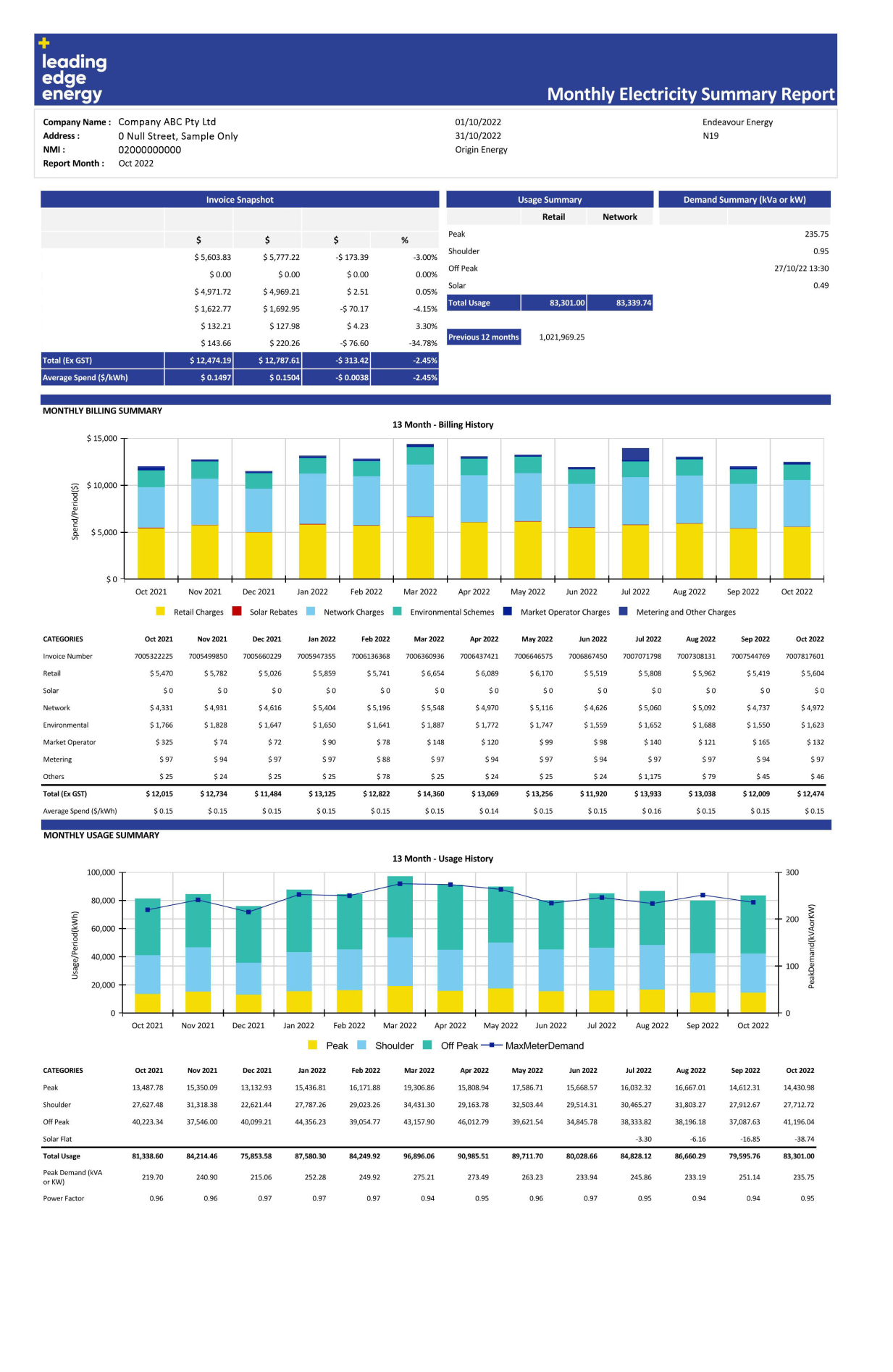
Reading Your Monthly Electricity Invoice Report
How to read Leading Edge Energy’s Monthly Electricity Summary Report
Learn how to read your monthly electricity summary report so you can efficiently manage energy costs and usage for your C&I business.
Leading Edge Energy emails commercial and industrial market customers a Monthly Electricity Summary Report.
We designed this report to explain how electricity invoices are computed by showing key information such as monthly and daily usage and costs, allowing businesses to manage and control how they use their electricity and plan their budget.

Billing Start: Billing Start The beginning of the billing period for the month.
Billing End: Billing End The last day of the billing period for the month.
Retailer: Retailer The company that sells electricity to end-consumers. Leading Edge Energy has a list of energy retailer partners here.
Network: Network This is the company that distributes electricity from the grid to end-users.
Tariff: Tariff A code assigned by the network that signifies how much the customer is charged for using electricity network infrastructure.
Oct 2022 Oct 2022 The current invoice or billing period.
Average of Invoices Average of Invoices The average charges from the most recent 13 months.
Movement Movement The difference between the invoice average and the current invoice.
Retail Charges Retail Charges The cost of electricity consumed by the business as set by the retailer.
Solar Rebates Solar Rebates This is an incentive given to businesses that have solar energy systems installed on their sites by approved retailers.
Network Charges Network Charges Also known as supply charges, these fixed, regulated rates are the cost of maintaining, building, and operating the network infrastructure to supply power to customers.
Environmental Schemes Environmental Schemes These are costs incurred by retailers as they comply with the requirements from the Renewable Energy Target and are passed on to the consumer.
Market Operator Charges Market Operator Charges These are fees charged by the AEMO to recover the costs of regulating the market and prevent further volatility. These include AEMO ancillary fees, Unaccounted for Energy, and RERT events.
Metering and Other Charges Metering and Other Charges These are fees paid to the metering service providers when a request is put in for changing, removing, or installing an electricity meter. This depends on the service requested.
14,430.98 Retail Peak This is the volume of electricity used by the customer during periods of high demand (when it’s most expensive).
27,712.72 Retail Shoulder This is the volume of electricity used by the customer between Peak and Off-peak periods.
41,196.04 Retail Off-peak This is how much electricity the customer uses when electricity demand is at its lowest – typically at night and during weekends.
-38.74 Retail Solar This is how much the customer used solar energy during the billing period.
0.00 Network Peak This is the customer’s electricity usage during peak times charged by the network. This can typically be managed by keeping actual usage below the levels agreed-upon with the distributor.
11,843.73 Network Shoulder This is how much the network charges the customer for using electricity during shoulder periods (the time between peak and off-peak).
71,496.01 Network Off-peak This is how the network charged the customer for using electricity when demand is lowest.
Peak Demand Peak Demand This is the highest demand reached during the time period. This especially impacts Time-of-Use pricing.
Power Factor Power Factor This is the measure of a location’s energy efficiency and is typically shown as a percentage. If the value is lower, that means the power usage is not very efficient.
Time & Date Time & Date The actual moment where the details under the Demand Summary is captured.
Load Factor Load Factor Load factor measures how efficiently the customer’s site uses electricity. Knowing this helps consumers save money if they’re able to adjust their usage during peak periods.
As a Leading Edge Energy client, we’re dedicated to helping you find smart, sustainable solutions to save your business money on energy and start on the path to energy efficiency and carbon reduction. One way we do this is by sending you an Electricity Summary Report each month to give you a better understanding of your business’ electricity consumption and costs for the past 13 months.
This page is a companion guide to our Monthly Electricity Summary Report so you can more clearly see what the different parts of the report are and why the data we show matters if you want to meet your business’ energy cost efficiency and sustainability goals.
Not yet a Leading Edge Energy client? Want to find opportunities to save on your business’ commercial or industrial energy bills?
Interested in getting personalised energy efficiency and cost reduction advice for your business? Your People in Power are ready to help
Get Started Here





